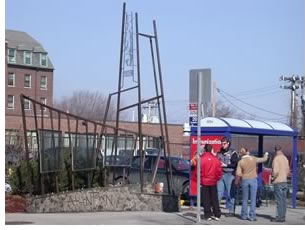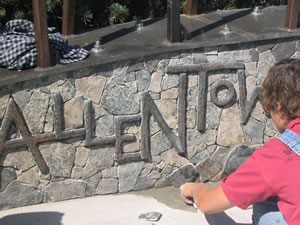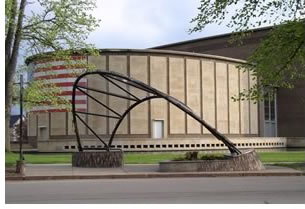

03/2005
 The National Council
of Architectural Registration Boards (NCARB) announced March 9 that it
has named the University at Buffalo/The State University of New York
(SUNY) as the grand prize winner of the 2005 NCARB Prize. With this honor,
the University at Buffalo Department of Architecture will receive $25,000.
The National Council
of Architectural Registration Boards (NCARB) announced March 9 that it
has named the University at Buffalo/The State University of New York
(SUNY) as the grand prize winner of the 2005 NCARB Prize. With this honor,
the University at Buffalo Department of Architecture will receive $25,000.
In the University of Buffalo/SUNY’s entry, “West Side Streetscape/Small Built Works Project,” more than 120 undergraduates and graduate students have created numerous projects within the framework of civic improvement. Initiated in Spring 2001 as part of a greater effort to further university-community collaboration, Small Built Works in Buffalo has focused on projects that emphasize green design, renewable energy strategies, and tectonics.
One small corner at a time
Clinical Assistant Professor Bradley A. Wales, AIA, reports that since
2001, some 120 seniors and graduate students have taken part in the
program, which draws from an elective studio as well as a construction-techniques
studio. As part of his elective studio, Wales encouraged the school
to work with the community, suggesting that “we go out and build.
The subtitle for the course is ‘How to Get Conceptual Works Built.’”
Professor Mehrdad Hadighi, chair of the architecture department, notes that the university’s architecture department has a long tradition of civic engagement that has resulted in a commitment to the City of Buffalo and the communities of which the school is a part. “We have simultaneously developed a tradition in the critical engagement of the design and making of architecture,” he says. “Professor Wales has, uniquely, brought these traditions together in the ‘Small Built Works’ Program.”
 The
eclectic mix of projects that has resulted includes three bus shelters,
a windmill in a new pocket park, a 17-foot-tall kiosk, four bike racks,
a granite monument to Frederick Law Olmsted, a sculpture park, and a
prize-winning Mardi Gras float complete with retractable roof. Students
work through the entire process, from conceptual design, schematics,
and presentation of proposals to community groups to preparing applications
for city and council approvals, creating shop drawings, and fabrication.
Different projects have involved students in making terra-cotta tiles,
pouring concrete, and steel welding. The community is also involved and
to date more than 100 community leaders and six community groups have
taken part in the projects while 35 companies have contributed in-kind
services.
The
eclectic mix of projects that has resulted includes three bus shelters,
a windmill in a new pocket park, a 17-foot-tall kiosk, four bike racks,
a granite monument to Frederick Law Olmsted, a sculpture park, and a
prize-winning Mardi Gras float complete with retractable roof. Students
work through the entire process, from conceptual design, schematics,
and presentation of proposals to community groups to preparing applications
for city and council approvals, creating shop drawings, and fabrication.
Different projects have involved students in making terra-cotta tiles,
pouring concrete, and steel welding. The community is also involved and
to date more than 100 community leaders and six community groups have
taken part in the projects while 35 companies have contributed in-kind
services.
Currently, the studio is working on a building project that entails adding a mezzanine and canopy for “El Museo,” a contemporary Latin American art museum. “Our project is unique because of the urban context,” Wales concludes. “Being in an urban area, I suggest to students that we can and need to improve the urban fabric ‘one small corner at a time.’”
Other programs lauded
Five other programs join the University at Buffalo/SUNY as winners of
the NCARB Prize for the Creative Integration of Practice and Education
in the Academy; each will receive a $7,500 award.
- “The Alumni Traveling Studio,” Miami University. Organized by alumni practitioners and faculty members, the traveling alumni studio model fully exposes students to the intricacies of practice. Reflecting alumni topics of expertise, the studio emphasizes such practical concerns as compliance with building codes, construction costs, and integration with other design disciplines.
- “The Big Box Studio in the Community Design Center,” University of Arkansas. The Big Box Studio develops community-based design solutions that are ecologically, socially, and economically responsive to big box retail, which has created its own form of urbanism. Originally commissioned by large discount retailers, the Big Box Studio works with leading industry designers and consultants to create best design practices and models addressing community development.
- “Bridging: The Links Between Practice and Education in the Academy,” University of Florida. This submission is based on a collaborative, comprehensive project that embraces a new understanding of “interdisciplinary bridges.” Students from a graduate architecture seminar in environmental technology and senior and graduate students in interior design work together to provide a design program for the renovation of a university building.
- “Organic Farm Market: A Collaborative Studio,” University of Illinois at Chicago. An accelerated design-build studio allows students to design, detail, and create permit documents, under the direct supervision of local architects, and then construct an organic farm market for the client, an internationally known conservation community. In this capstone graduate project, students focus on the principles of sustainable design and build full-scale mock-ups for client approval.
- “Chicago Studio,” Virginia Polytechnic Institute and State University. This entry provides an alternate model for a traditional upper-level design studio. The studio is built around a series of integrated, collaborative courses that introduce daily professional practice activities in an urban setting. Student teams create a collective master plan for one of three sites along the Chicago River; each student then designs a building for that master plan.
Entries from North Carolina State University (“Making Connections | Building Knowledge: An Assessment of Construction Management at Risk”) and from the University of Utah (“designbuildBLUFF”) received honorable mentions.
 High-quality submissions
High-quality submissions
Thirty-three entries representing 26 different colleges and universities
were juried for this year’s NCARB Prize. Speaking on behalf of
the NCARB Prize jury, Campbell noted, “The fourth year of the
NCARB Prize has brought together yet another outstanding group of diverse,
thought-provoking projects. Once again, we are very pleased with the
high quality of the winning programs. The University at Buffalo’s
remarkable entry maintains the high standards of our previous grand
prize-winning submissions from Oklahoma State University, the University
of Kansas, and the University of Detroit Mercy.”
The NCARB Prize for Creative Integration of Practice and Education in the Academy was initiated in Fall 2001. The prize is inspired by the 1996 Carnegie Foundation report, Building Community: A New Future for Architectural Education and Practice, by Lee D. Mitgang and the late Ernest L. Boyer.
Copyright 2005 The American Institute of Architects.
All rights reserved. Home Page ![]()
![]()
